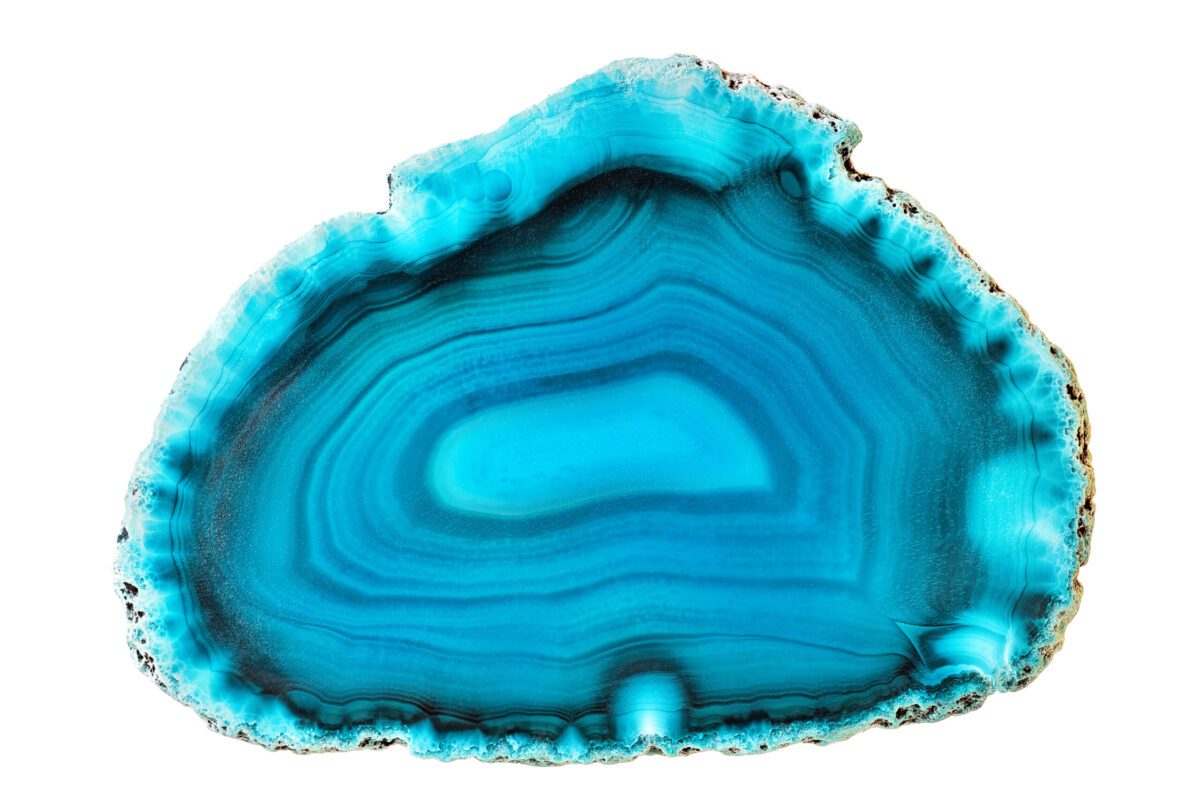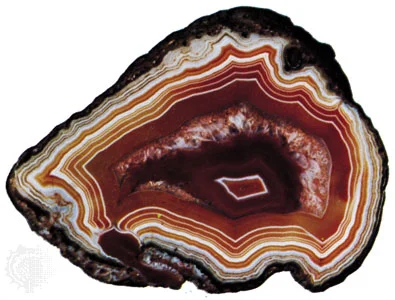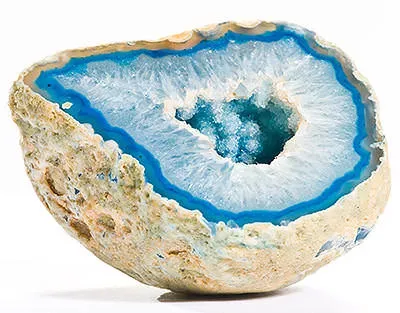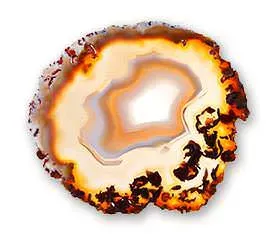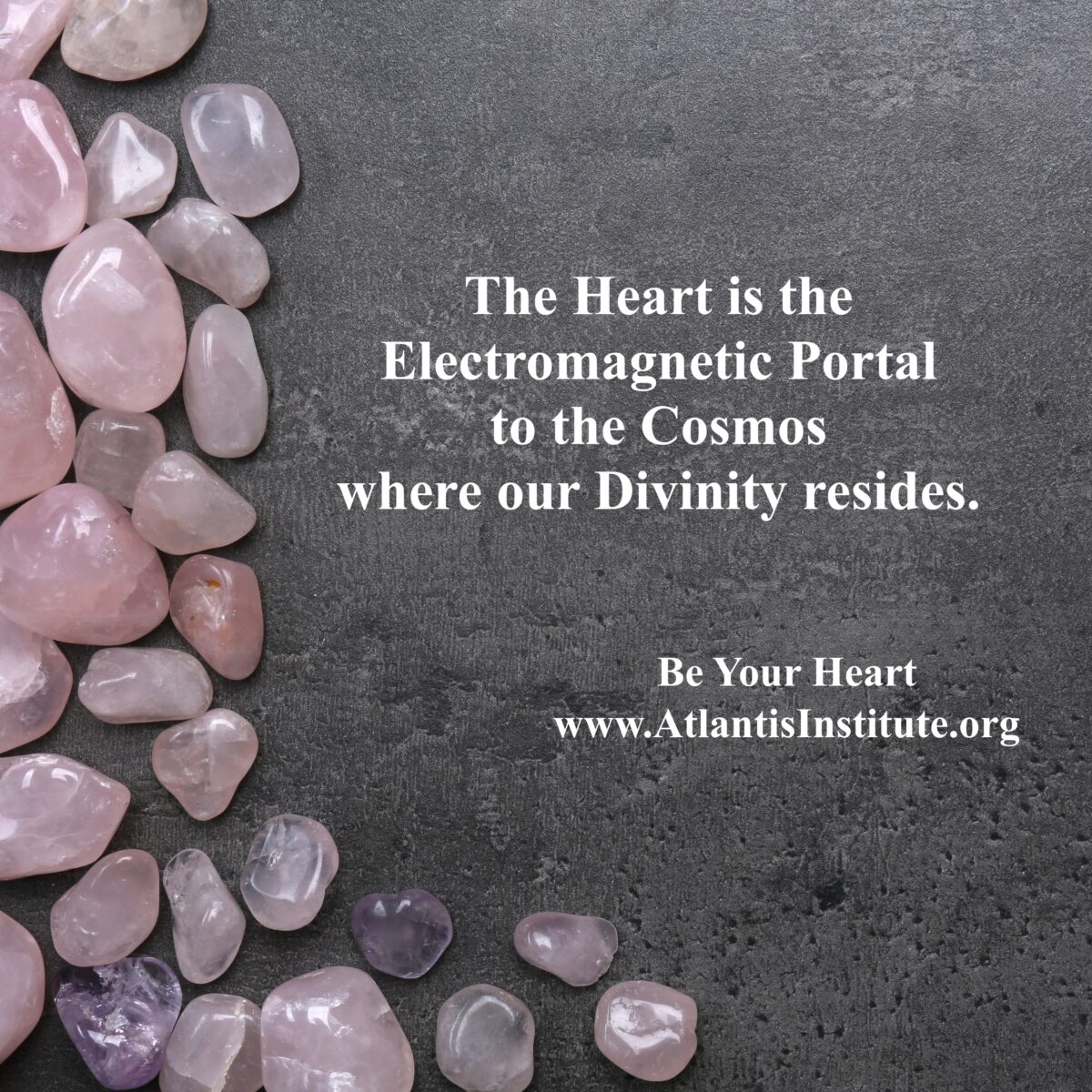AGATE – Atlantis Institute Crystals Encyclopedia
Origin
Agate is a crystal of primary formation, meaning it was formed from molten magma. This usually happens in cavities in volcanoes where the combination of chemistry and structural arrangements of mineral deposits, atoms and substances pass from gas or liquid into a solid state or by means of going out of solution by precipitation or evaporation.
Agate is made up of silicon dioxide, a variety of Chalcedony, which is a part of the Quartz family. The intricate bands found in Agate crystals are said to result from saline water trapped in the gas. When it starts to cool, it begins to fight the iron in the lava by pushing off the walls of its cavities, creating a rippling effect and subsequent beauty in its formation.
Although Agate crystals are often found in volcanic rocks, they can also be found in many other rocks, including metamorphic rocks.
All crystals belong to a different group according to the basis of the relationships of their axes. There are seven systems and 32 classes of symmetry. Agate crystals belong to the Trigonal system.
History
Ancient myth tells the story of this interesting and unique crystal stone being found in the Achates river in Sicily, which was a Greek colony at the time.
The river is now known as the Drillo River, but the old Greek word ‘Agateec’, which means happy, was adopted as this beautiful crystals name. A greek philosopher named Theophrastus is said to have discovered the stone between the 4th and 3rd centuries BC.
Agate is said to have been widely used in ancient Egypt and became popular throughout the middle ages in Europe. It has grown in popularity over the years mainly due to its unique and interesting designs. Agate and its different variants are now widely sought throughout the world.
Medieval civilisations used agate to give protection from danger and bring victory and strength; it also was used to bring favour with the Gods.
Agate was also discovered amongst Neolithic artefacts. Agate has a lower intensity and vibration than most, yet is regarded as being grounded and stabilised.
Specification
In their raw form, they are rough and need to be polished down to reveal the stone's true form and unique style. They come in many different colours, and each one will be different in design. Many Agate crystals have a band-like design running through them, somewhat similar to the rings on an old tree.
A very strong stone and is specifically good at resisting acids. It is also widely used to create ornaments and jewellery. Comes in a variety of shapes, sizes and patterns and is known for its glass-like appearance when polished.
Varieties
There are many different varieties of Agate; these include and are not limited to;
- Natural
- Fire
- Fortification
- Blue Lace or Crazy Lace
- Pink, Apricot
- Red, Blood
- Dendritic
- Eye
- Layered, Banded
- Snakeskin
- Star
- Tubular
- White Peace
- White/black Zebra
Esoteric Attributes
By their very nature, Crystals can receive and focus energy in different ways. Their molecular structure enables them to be used to amplify and convert energy. Hence, crystals have been used for centuries to aid healing and transmute energy both in the metaphysical and physical world.
Because each crystal family has different formational backgrounds, each also has different vibrational frequencies that can be harnessed and used for specific purposes. Each, therefore, has specific qualities that can be used to help a person heal on the many different levels of their being.
Healing attributes associated with Agate crystals.
Mental: They are said to help a person enhance their sense of reality and develop pragmatic thinking skills.
Emotional: It can assist a person in developing inner stability and composure within themselves and aids them in harnessing their maturity. It is also a very good crystal for building self-confidence, security and warmth.
Physical: Agate crystals are primarily used to aid physical healing for the eyes, stomach, blood vessels and skin. It is a strong protection stone and is known especially for its protective qualities during pregnancy.
Crystal Chart - Agate
Crystal: Agate
Mineralogy: Banded Quartz - Silicon dioxide, SiO2
Geometric form: Trigonal
Formation: Primary (molten magma)
Family: Quartz
Birthstone: Ayurvedic Birthstones - Agate is the stone associated with May.
Astrology Birthstone (Zodiac) -Agate is associated with the astrological sign of Gemini (21st May to 20th June).
Appearance: Glass-like waxy lustre, white streak, translucent, striped, banded.
Aura: Often used to remove and transform negative energy from the aura and can help cleanse
and stabilise it, bringing about a calmer and more balanced energy flow within.
Colour: Colours range from soft milky browns, greys, pinks, blues, white and orange to more vibrant coloured reds,
greens and reds also appear in striking variants of black and banded shades and patterns.
Chakra: Can help remove blocks within all the chakra, with specific colours being more attuned to their
corresponding chakra.
References and resources:
Michael Gienger, Healing Crystals, Earthdancer Books, 2009
The Columbia Encyclopedia, Crystal, 6th ed. 2014
World of Earth Science, Quartz, 2003
Encyclopedia of Occultism and Parapsychology, Crystal Healing, 2001
http://gemstone-dictionary.com/birthstones-by-month.php
New Oxford American Dictionary
Learn to become a Crystal Therapist















